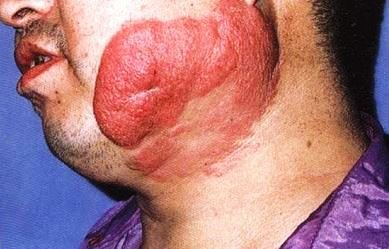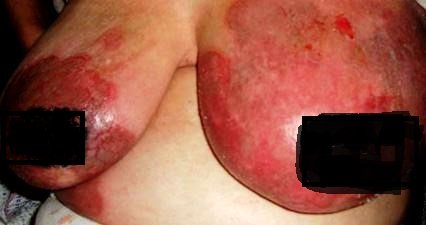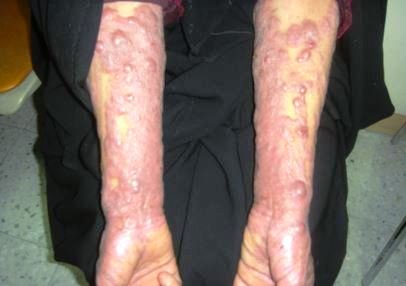Mycosis Fungoides Definition
Mycosis fungoides which is also referred to as Alibert-Bazin syndrome is a rare skin cancer. This condition is the most common variety of cutaneous T cell lymphoma (CTCL). CTCL is a type of malignancy wherein the special kind of white blood cells called T-lymphocytes become infectious and drawn or deposited to the skin.

Mycosis fungoides is responsible for almost 50% of all cutaneous lymphomas that are primary and is more common in males than in females but rarely occurs in children.
Symptoms
In general, mycosis fungoides is described with patches or plaques coating the surface of the skin. The skin lesions or patches are unevenly scattered in certain skin areas like in the breasts, lower trunks, groin, hips, and buttocks. If the condition arises in an earlier stage, it will be more difficult to diagnose since the disease might mimic other non-cancerous skin disorders.
The progression of mycosis fungoides is divided into stages based on the skin symptoms:
Patch stage
The skin lesions are flat and they are usually ring-shaped or oval patches that are pink in color. The patches may sometimes itch or grow slowly and the skin might be thinned.
Plaque stage
The patches become more itchy and thickened. They could possibly resemble psoriasis which is a chronic skin problem.
Tumor stage
Large asymmetrical nodules develop from plaques similar to a mushroom and could ulcerate. At this phase, the spread to other organs is more common than earlier stages. There is also a possibility that the tumor can progress to a large cell lymphoma.
Causes & Pathology
The specific cause of the disease is unknown but some studies had noted that it might be due to the rapid production of T-lymphocytes or T-cells. These T-cells are accountable for the management of the body’s immune system in its job of battling infections and other harmful organisms inside the body.
The condition is not associated with any genetic causes in most cases. It is believed to be caused by certain changes in a person’s DNA that led to lymphoma cells of the usual lymphocytes. The disease is not inherited from the parents and commonly occurs as the person’s age progresses.
Based on the researchers, there are several theories that can also prompt the disease such as environmental, viral, or occupational exposures, and other types of chronic antigenic stimulation.
Staging
Stage I
No tumors are present. The cancer only influences certain skin areas which has flaky, red, and dry patches.
Stage II
No tumors are present but there are scurfy and red patches on the skin. Lymph nodes are much larger than usual but contain no cancer cells; or tumors are present on the skin and lymph nodes too but cancer cells are not present.
Stage III
Almost all skin areas is scaly, dry, and red. Lymph nodes are larger or normal in size but no cancer cells are present.
Stage IV
Cancer cells are cited in the lymph nodes and cancer had spread to other organs of the body.
Treatment
The treatments for mycosis fungoides depends on the extent of the cancer from the time it was diagnosed including the patient’s overall health condition. Each treatment plan is different from each individual since it is based on the patient’s needs.
The goals of the treatment is to ease the symptoms and for cosmetic reasons. Mycosis fungoides had already been agreed in general that it cannot be cured with the current therapies available.
Standard treatments for the condition in the early stage may involve:
Electron beam radiation
This is a special kind of radiation therapy that has small particles that are charged electrically through a machine and directed to the skin.
Topical application
The use of corticosteroid creams or retinoid gel that is applied on the skin can be an option for curing an early stage disease.
Chemotherapy
This treatment uses certain chemical substances or drugs to kill cancer cells. It can be used when the cancer is on the last stage and still does not respond to other skin treatments.
Phototherapy
It uses ultraviolet light to treat several skin conditions that can be used alone or combined with other medications.
Interferon alfa
It is commonly used and is injected subcutaneously. This option is best recommended when the disease is in tumor stage and has unsuccessful response to skin treatments.
Prognosis
Mycosis fungoides can become life-threatening on its advance stage and could be disfiguring. The condition is not curable since the primary aim of treatment is the life quality of the person and to make the most of the remission period.
A patient’s degree of survival relied on the extent of the spread from the time the disease was first diagnosed. Patients who are diagnosed in earlier stages can live a normal course of life and die of unassociated causes.
Pictures




Image 5 – Mycosis fungoides on legs
References
- http://dermnetnz.org/dermal-infiltrative/cutaneous-t-cell-lymphoma.html
- http://healthh.com/mycosis-fungoides/
- http://www.efpia.eu/diseases/15/59/Mycosis-Fungoides
- Dummer R, Duvic M, Scarisbrick J, Olsen EA, Rozati S, Eggmann N, et al (2014 Jun 19). Final results of a multicenter phase II study of the purine nucleoside phosphorylase (PNP) inhibitor forodesine in patients with advanced cutaneous T-cell lymphomas (CTCL) (Mycosis fungoides and Sézary Syndrome). Ann Oncol.
- D’Acunto C, Gurioli C, Neri I (2010 Jan. 21). Plaque stage mycosis fungoides treated with bexarotene at low dosage and UVB-NB. J Dermatolog Treat. (1):45-8.
- Furmanczyk PS, Wolgamot GM, Kussick SJ, Sabath DE, Olerud JE, Argenyi ZB (2010 Jan). Diagnosis of mycosis fungoides with different algorithmic approaches. J Cutan Pathol. 37(1):8-14.
Similar Posts:
- Mast Cell Tumor
- Tongue Cancer Pictures, Symptoms, Treatment, Prognosis, Survival Rate
- Squamous Cell Carcinoma in Situ – Pictures, Treatment, Symptoms
- Leiomyosarcoma – Survival Rate, Symptoms, Prognosis, Treatment
- Medullary Thyroid Cancer – Symptoms, Treatment, Prognosis
- Angiosarcoma – Prognosis, Symptoms, Treatment, Pictures, Causes
- Amelanotic Melanoma – Pictures, Symptoms, Prognosis






Leave a Reply